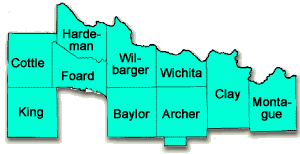Region B
2005 Regional Water Plan Overview

Regional Facts

Major Cities | Wichita Falls |
| Population: 2000 | 201,970 |
| Population: 2060 | 221,734 |
| Total Water Use: 2000 | 169,767 Acre-Feet |
| Total Water Use: 2060 | 169,152 Acre-Feet |
| Primary Rivers | Red |
| Major Aquifers | Seymour, Nacotoch |
| Annual Precipitation | 20-36 Inches |
| Net Evaporation | 36-52 Inches |
Basic Plan Facts
- Region expected to experience only a low population growth by 2060
- Total capital cost of proposed water supply measures: Not Available
- No new reservoirs proposed
What's at Issue?
The regional plan projects that all water demands in the region will be met through 2060. However, there are water needs in the region that were not accounted for in the planning process. Environmental water flows are integral to protecting the natural resources of this region, and constitute a true demand for water. The area's natural resources include numerous natural springs, and the region is home to at least five endangered bird species: whooping crane, bald eagle, interior least tern, black-capped vireo, and golden-cheeked warbler.
Action Items
Here are some of the items the Region B Planning Group must address.
 Conservation and Drought Management
Conservation and Drought Management
For conservation and drought management, the plan needs to...
- Identify a goal for municipal water usage rates in the region. It is also important that the group adopt a water conservation package for municipal water user groups.
- Consider conservation as a supply strategy for manufacturing and steam electric uses.
- Recognize the potential for agricultural/ irrigation conservation.
- Include drought management as a water management strategy. Each water user group with a shortage should use a drought management strategy derived from its drought management plan as a way to meet their water needs. The regional plans in the state are based on a drought of record and it only makes sense that drought management should play a large role in planning to meet the region's water needs during that drought period.
 Environmental Flows
Environmental Flows
To secure the protection of flows for fish and wildlife, the plan needs to...
- Recognize environmental flows as a water demand and plan to provide for reasonable levels of environmental flows.
- Analyze the environmental impacts of the proposed water management strategies.
- Include information on the wetlands in the region.
- Designate stream segments in the region that meet the criteria as having "unique ecological value". The Texas Parks and Wildlife Department recommends 3 segments for designation in this region.
 Groundwater Management
Groundwater Management
To ensure the long term viability of the state's groundwater resources, the plan needs to...
- Characterize current aquifer and spring conditions and trends
- Include a clear groundwater management policy, preferably a sustained yield approach. This mode of management would provide groundwater of reasonable quantity and quality for many generations to come.
- Include information about any regulatory limits to pumping from the region's groundwater conservation districts.



 Region B
Region B